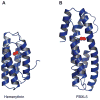Protein degradation and iron homeostasis
- PMID: 22349011
- PMCID: PMC3580239
- DOI: 10.1016/j.bbamcr.2012.02.003
Protein degradation and iron homeostasis
Abstract
Regulation of both systemic and cellular iron homeostasis requires the capacity to sense iron levels and appropriately modify the expression of iron metabolism genes. These responses are coordinated through the efforts of several key regulatory factors including F-box and Leucine-rich Repeat Protein 5 (FBXL5), Iron Regulatory Proteins (IRPs), Hypoxia Inducible Factor (HIF), and ferroportin. Notably, the stability of each of these proteins is regulated in response to iron. Recent discoveries have greatly advanced our understanding of the molecular mechanisms governing iron-sensing and protein degradation within these pathways. It has become clear that iron's privileged roles in both enzyme catalysis and protein structure contribute to its regulation of protein stability. Moreover, these multiple pathways intersect with one another in larger regulatory networks to maintain iron homeostasis. This article is part of a Special Issue entitled: Cell Biology of Metals.
Copyright © 2012 Elsevier B.V. All rights reserved.
Figures






Similar articles
-
Murine mutants in the study of systemic iron metabolism and its disorders: an update on recent advances.Biochim Biophys Acta. 2012 Sep;1823(9):1444-50. doi: 10.1016/j.bbamcr.2012.01.011. Epub 2012 Jan 28. Biochim Biophys Acta. 2012. PMID: 22306267 Free PMC article. Review.
-
Regulation of cellular iron metabolism: Iron-dependent degradation of IRP by SCFFBXL5 ubiquitin ligase.Free Radic Biol Med. 2019 Mar;133:64-68. doi: 10.1016/j.freeradbiomed.2018.09.011. Epub 2018 Sep 13. Free Radic Biol Med. 2019. PMID: 30218771 Review.
-
Hemerythrin-like domain within F-box and leucine-rich repeat protein 5 (FBXL5) communicates cellular iron and oxygen availability by distinct mechanisms.J Biol Chem. 2012 Jul 6;287(28):23710-7. doi: 10.1074/jbc.M112.360404. Epub 2012 May 30. J Biol Chem. 2012. PMID: 22648410 Free PMC article.
-
F-box and leucine-rich repeat protein 5 (FBXL5) is required for maintenance of cellular and systemic iron homeostasis.J Biol Chem. 2013 Jan 4;288(1):552-60. doi: 10.1074/jbc.M112.426171. Epub 2012 Nov 7. J Biol Chem. 2013. PMID: 23135277 Free PMC article.
-
Structural and molecular characterization of iron-sensing hemerythrin-like domain within F-box and leucine-rich repeat protein 5 (FBXL5).J Biol Chem. 2012 Mar 2;287(10):7357-65. doi: 10.1074/jbc.M111.308684. Epub 2012 Jan 17. J Biol Chem. 2012. PMID: 22253436 Free PMC article.
Cited by
-
Iron homeostasis and organismal aging.Ageing Res Rev. 2021 Dec;72:101510. doi: 10.1016/j.arr.2021.101510. Epub 2021 Nov 9. Ageing Res Rev. 2021. PMID: 34767974 Free PMC article. Review.
-
F-box and leucine-rich repeat protein 5 (FBXL5): sensing intracellular iron and oxygen.J Inorg Biochem. 2014 Apr;133:73-7. doi: 10.1016/j.jinorgbio.2014.01.015. Epub 2014 Jan 25. J Inorg Biochem. 2014. PMID: 24508277 Free PMC article. Review.
-
Involvement of Iron-Containing Proteins in Genome Integrity in Arabidopsis Thaliana.Genome Integr. 2015 Apr 28;6:2. doi: 10.4103/2041-9414.155953. eCollection 2015. Genome Integr. 2015. PMID: 27330736 Free PMC article. Review.
-
The role of mitochondria in cellular iron-sulfur protein biogenesis: mechanisms, connected processes, and diseases.Cold Spring Harb Perspect Biol. 2013 Aug 1;5(8):a011312. doi: 10.1101/cshperspect.a011312. Cold Spring Harb Perspect Biol. 2013. PMID: 23906713 Free PMC article. Review.
-
Altered Iron Metabolism and Impact in Cancer Biology, Metastasis, and Immunology.Front Oncol. 2020 Apr 9;10:476. doi: 10.3389/fonc.2020.00476. eCollection 2020. Front Oncol. 2020. PMID: 32328462 Free PMC article. Review.
References
-
- Crichton RR, Pierre JL. Old iron, young copper: from Mars to Venus. Biometals. 2001;14:99–112. - PubMed
-
- Klausner RD, Rouault TA, Harford JB. Regulating the fate of mRNA: the control of cellular iron metabolism. Cell. 1993;72:19–28. - PubMed
-
- Hentze MW, Muckenthaler MU, Andrews NC. Balancing acts: molecular control of mammalian iron metabolism. Cell. 2004;117:285–297. - PubMed
-
- Andrews NC, Schmidt PJ. Iron homeostasis. Annu Rev Physiol. 2007;69:69–85. - PubMed
-
- Muckenthaler MU, Galy B, Hentze MW. Systemic iron homeostasis and the iron-responsive element/iron-regulatory protein (IRE/IRP) regulatory network. Annu Rev Nutr. 2008;28:197–213. - PubMed
Publication types
MeSH terms
Substances
Grants and funding
LinkOut - more resources
Full Text Sources
Medical

